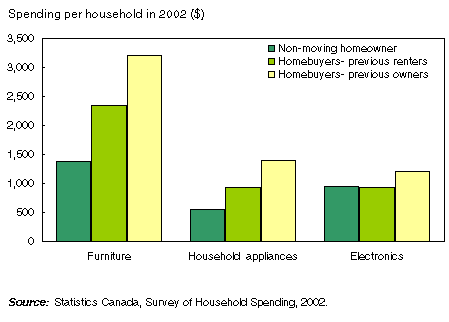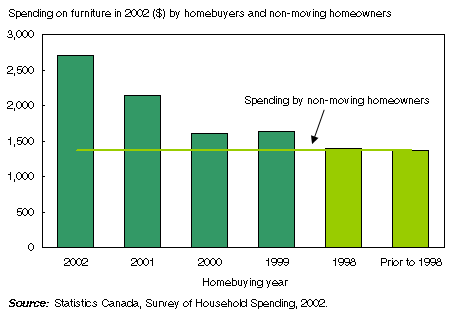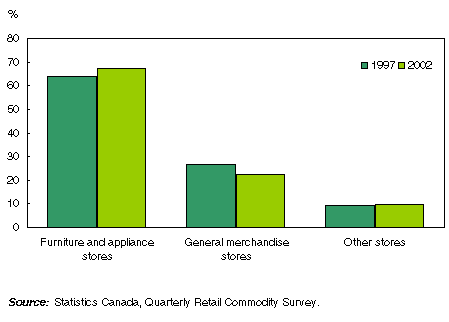Common menu bar links
On the move with homebuyers: Shopping for furniture
Archived Content
Information identified as archived is provided for reference, research or recordkeeping purposes. It is not subject to the Government of Canada Web Standards and has not been altered or updated since it was archived. Please "contact us" to request a format other than those available.
by Jane Lin
Distributive Trades Division

Summary
Furniture and appliance sales through the roof
On the move with homebuyers
Homebuyers spend twice as much as non-moving homeowners on furniture
Homebuyers spend more on furniture three years after move
Recent homebuyers make up one-fifth of furniture spending in 2002
What and where shoppers bought
Furniture and appliance stores still dominate $18 billion market
Summary
Canada’s red hot housing market has contributed to the fast sales growth at furniture and appliance retailers.
In 2002, retail stores recorded $24.5 billion in sales of home furnishings and electronics, an 8.1% gain from 2001. Sales of major appliances rose 14.2%, the strongest growth to date.
Part of this staggering growth was due to Canada’s robust housing market and low borrowing costs. Housing starts hit a record 15-year high in 2003, following strong growth in 2002, mirroring the stellar performance of existing home sales.
An estimated 472,886 households bought a home in 2002, spending $1.3 billion on furniture.
However, homebuyers were a mere 4% of the total household population and accounted for 8% of the total household spending on furniture in 2002.
On average, homebuyers spent twice as much on furniture in 2002 as homeowners who did not move. Furthermore, homebuyers who owned their previous home spent nearly three times more than non-moving homeowners on household appliances.
And too, homebuyers don’t stop shopping for furniture right after their move. Data show that three years later, they still spend more than homeowners who don’t move.
This article analyzes spending by homebuyers on furniture using the 2002 Survey of Household Spending. It also looks at retail sales growth in furniture and appliance stores using the Monthly Retail Trade Survey and the Quarterly Retail Commodity Survey.
Note to readers:
"Homebuyers" in this article are defined as households that indicated in the Survey of Household Spending, that on December 31, 2002 their current dwelling was owned and that also indicated that their household moved into this dwelling in 2002. These households are split into "previous renters" and "previous owners", for those who rented their previous dwelling and those households who owned their previous home respectively.
"Non-moving households" include renters as well as non-moving homeowners.
"Non-moving homeowners" indicated they owned their dwelling on December 31, 2002 and moved into their residence prior to 1999.
Furniture and appliance sales through the roof
The recent housing boom has been given credit lately for stimulating sales growth in furniture and appliance stores. These retailers have enjoyed the fastest growth in the retail industry since at least 1997, well before interest rates dropped and the housing activity took off by mid-2001.
Furniture and appliance retailers recorded tremendous sales growth for both appliances and furniture products in 2001 and 2002, when just under a million households bought a home.
This was especially evident in 2002: appliance sales totalled $2.2 billion in these stores, a 19.4% gain from 2001, while furniture sales increased 9.3% to more than $4.8 billion.
In contrast, between 1997 and 2000, furniture and appliance sales were weak while the housing market was relatively stable.
Electronic sales did not suffer the same fate during this period. In fact, sales from electronics were averaging growth of over 10% on a year-over-year basis, which fuelled sales in overall furniture and appliance stores. This was a period when prices for electronics were falling.
The housing boom, however, explains only part of the recent growth in furniture and appliance store sales. Homebuyers, who represented a small 4% of the household population in 2002, contributed 8% or $1.3 billion towards total spending on furniture.
This means that through the ups and downs of the housing market, it was the non-moving households that purchased the bulk of furniture.
These households might have shopped at furniture and appliance stores to replace a 25-year old fridge, install a quieter dishwasher or splurge on a big-screen television. Such purchases were unrelated to buying a home.
On the move with homebuyers
Fuelled by favourable borrowing rates and strong employment growth, housing starts hit a record 15-year high in 2003, mirroring the stellar performance of existing home sales. After October 2001, housing starts took off, reaching new heights by January 2002.
At the moment, older children of the baby boomers and younger baby busters are entering the prime borrowing years of their late 20s to early 30s. According to the 2001 Census,1 there were 4.1 million Canadians between the ages of 26 and 35. They are buying their first homes, setting up households, and buying cars and furniture, just as their parents did in the 1960s and 1970s.2
Many Canadians were on the move to buy a home — whether they were first time homebuyers, existing home owners seeking a trade-up from their current dwellings, or empty-nesters looking for a different type of residence.
The Survey of Household Spending estimates 472,886 households moved into a home of their own in 2002, half from an owned home and half from a rented dwelling. Those who previously rented were younger and had a lower household income on average, compared to those who owned their previous dwelling.
On average non-moving homeowners were 56 years old in 2002. This was significantly older than the homebuyer average of 38 for previous renters, and 47 for previous owners.
Homebuyers spend twice as much as non-moving homeowners on furniture
In 2002, homebuyers spent twice as much as non-moving homeowners on household furniture. On average, homebuyers spent $2,788, compared with $1,371 for non-moving homeowners.
Interestingly, homebuyers who previously owned their homes spent 37% more on furniture than homebuyers who rented their previous dwellings. Previous owners spent an average of $3,213 to furnish their new dwellings, while those who previously rented spent $2,342. And although previous renters averaged a lower household income than the non-moving homeowners, they still spent more on furniture.
With small appliances and major appliances, the spending pattern was similar. Homebuyers who previously rented their homes spent almost twice as much as non-moving homeowners. Previous owners spent nearly three times more than non-moving homeowners.
Previous owners spent 50% more on appliances than homebuyers who previously rented their homes.
This pattern of overall spending on furniture and appliances also holds true for different household income levels. For example, a previous owner, earning less than $50,000 in household income, would spend more than a previous renter, or a non-moving homeowner household.
Chart
Previous owners spent nearly three times more than non-moving homeowners on household appliances in 2002

Besides sofas, refrigerators, and cappuccino makers, shoppers also purchase electronic "toys" such as computers, digital cameras and home entertainment equipment.
However, moving into a home of one’s own does not seem to have as much impact on electronic purchases as it does on furniture purchases.
Non-moving homeowners spent roughly the same amount as homebuying households on electronics. Homebuyers who previously owned their residence spent slightly more on electronics than the two other groups.
This might be one of the contributing factors to why some furniture and appliance stores performed well even during relatively slow housing activity periods — many of them sell electronics.
Homebuyers spend more on furniture three years after move
Homebuyers do not purchase all the furniture they want or need in the first year of their move. Typically, their spending continues over the next three years, as they shop for those extra pieces of furniture that perhaps weren’t a priority when they moved.
On average homebuyers spend less and less on furniture each year after a move until their spending resembles that of a non-moving homeowner.
Homebuyers that moved in 2001 spent 56% more dollars on furniture than non-moving homeowners in 2002. Homebuyers that moved in 2000 and 1999 spent roughly 17% more than non-moving homeowners in 2002. Non-moving homeowners spent $1,371 on furniture, which is represented in the following chart by the horizontal line.
Chart
Shopping for furniture continues for several years after a move

Recent homebuyers make up one-fifth of furniture spending in 2002
Recent homebuyers, who made their move in the four years from 1999 to 2002, accounted for over one-fifth (22%) of the total household spending on furniture, according to the 2002 Survey of Household Spending.
The other four-fifths (78%) of furniture spending is attributable to households who are renting or bought their home prior to 1999 and which form the majority of the Canadian household population.
It is also likely that the same factors, strong employment and favourable borrowing rates, encouraged some non-homebuyers to spend on furniture, just as they were factors in encouraging homebuyers to buy a home in 2001 and 2002.
What and where shoppers bought
In 2002, furniture, appliances, and electronics sales made up a hefty 84% in overall furniture and appliance store sales. Electronics made up 36%, furniture 33%, and household appliances, 15%.
Home furnishings made up an additional 3% of sales. These furnishings included items such as floor coverings, lamps, clocks, window treatments, and bedding and linen.
The remaining 13% of sales went to other items such as tableware, CDs, DVDs, outdoor furniture and equipment, and included receipts from repairs and services. These proportions have remained relatively stable over the past several years.
Furniture and appliance stores still dominate $18 billion market
Furniture and appliance retailers continued to dominate furniture, appliance and electronics sales, capturing 67% of the market in 2002, up from 64% in 1997. This increase translated to an additional $617 million for these retailers in 2002.
Meanwhile, the market share of general merchandise stores, including department stores, fell from 27% in 1997 to 23% by 2002. A few of these well-known general merchandise stores spun off their home furnishings into separate household furnishing stores.
Among other stores that sell furniture, appliances and electronics are: supermarkets, drug stores and household furnishings stores.
Chart
Furniture and appliance stores dominate $18 billion market for household furniture, appliances, and electronics

Data Sources
The Monthly Retail Trade Survey (MRTS)collects sales and the number of retail locations by province and territory from a sample of roughly 12,000 retail businesses. The MRTS universe is based on the 1980 Standard Industrial Classification. Each month, data for retail sales are published by province and for 16 trade groups in The Daily, Statistics Canada’s official release bulletin.
The Quarterly Retail Commodity Survey (QRCS) looks at commodity sales within and across various types of stores. The sample is a subset of the Monthly Retail Trade Survey sample, and includes more than 8,000 businesses and over 100 commodities. It supplements the MRTS by providing a breakdown of retail sales by commodity.
The Survey of Household Spending (SHS) is an annual survey that obtains detailed information about household spending during the reference year. Information is also collected about dwelling characteristics and household appliances and equipment owned, as of December 31 of the reference year. This analysis uses 2002 as the reference year and includes only full year households. Full year households have at least one person who was a member of the household for the entire year.
SHS spending and QRCS sales levels do not line up. QRCS measures sales from retail businesses. SHS collects household spending information from private households leaving out businesses and institutional spending.
For more information about these three surveys, visit the Statistics Canada Integrated Metadatabase (IMDB): Quarterly Retail Commodity Survey 2008, Survey of Household Spending 3508 and the Monthly Retail Trade Survey 2406.
Footnotes
- Statistics Canada. 2001. 2001 Census. "Age (122) and Sex (3) for Population, for Canada, Provinces, Territories, Census Metropolitan Areas and Census Agglomerations, 2001 Census – 100% Data." Catalogue no. 95F0300XIE. (accessed April 7, 2004).
- Foot, David K. 2001. "Turning up the economic heat". December 10. (accessed April 6, 2004).

